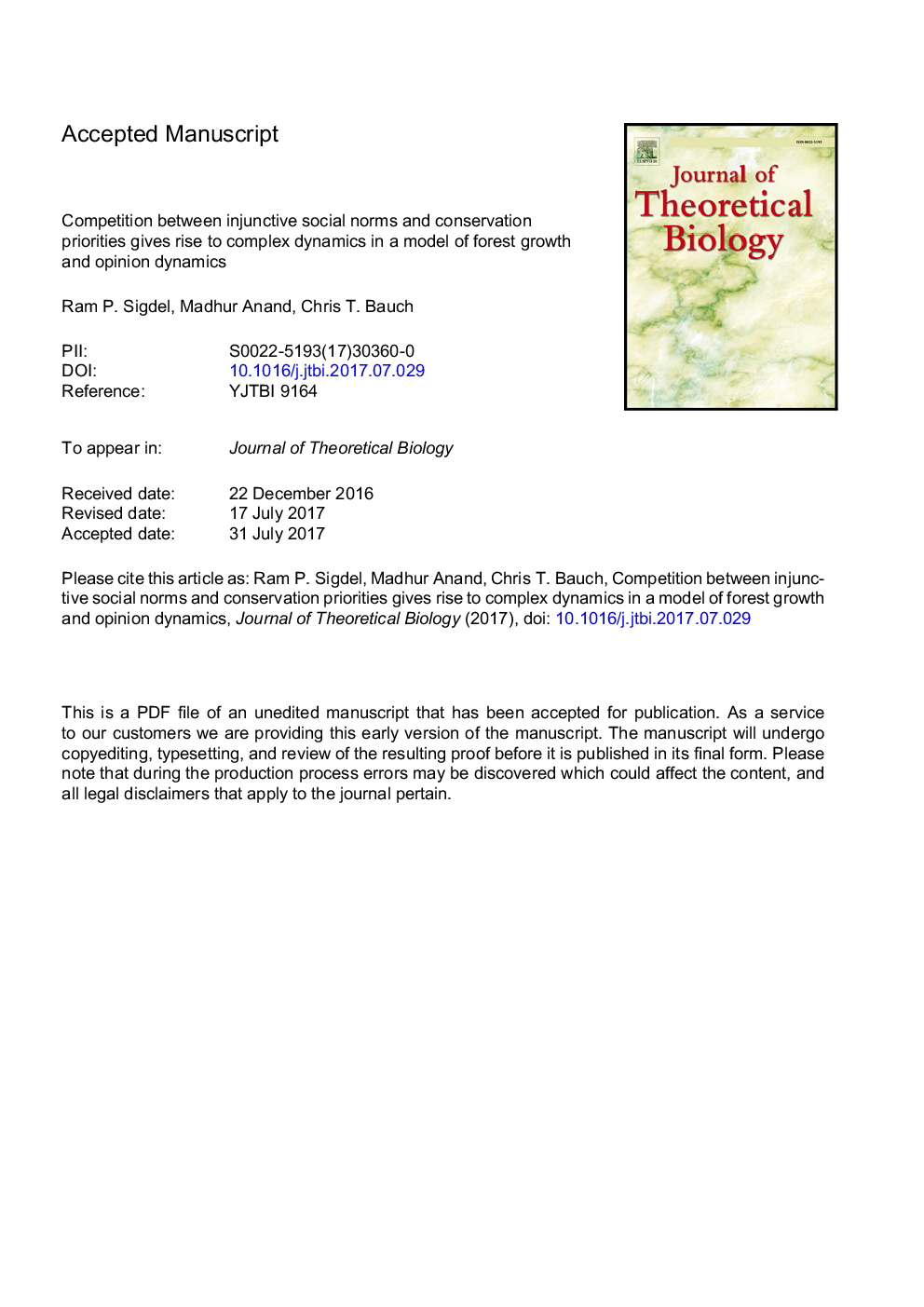| کد مقاله | کد نشریه | سال انتشار | مقاله انگلیسی | نسخه تمام متن |
|---|---|---|---|---|
| 5760275 | 1623778 | 2017 | 33 صفحه PDF | دانلود رایگان |
عنوان انگلیسی مقاله ISI
Competition between injunctive social norms and conservation priorities gives rise to complex dynamics in a model of forest growth and opinion dynamics
ترجمه فارسی عنوان
رقابت بین هنجارهای اجتماعی پیشنهادی و اولویت های حفاظت، موجب دینامیکی پیچیده در یک مدل رشد جنگل و پویایی نظریه می شود
دانلود مقاله + سفارش ترجمه
دانلود مقاله ISI انگلیسی
رایگان برای ایرانیان
کلمات کلیدی
ارزش نگهداری، پویایی تقلید، سیستم اجتماعی و زیست محیطی، مدل معادلات دیفرانسیل، کشورهای ثبات جایگزین، انتقال جنگل، تغییر رژیم،
ترجمه چکیده
سیستم های انسانی و زیست محیطی اغلب به عنوان جدا از یکدیگر در نظر گرفته می شوند در حالی که در واقع آنها اغلب دو بخش از سیستم یکپارچه و یکپارچه سیستم انسانی هستند. در حال توسعه مدل های نظری سیستم های محیط زیست انسانی یک منطقه مستمر تحقیق است، اگرچه نسبتا تعداد کمی از این مدل ها مبتنی بر معادلات دیفرانسیل است. در اینجا ما یک معادله دیفرانسیل ساده و یک سیستم مدل سازمانی انسانی از دینامیک رشد جنگل و پویایی ادراک حفاظت از طبیعت در یک جمعیت انسانی ایجاد می کنیم. این مدل به دنبال رشد و تدارکات لجستیکی در جنگل است. دیدگاه گسترش یافته در جمعیت انسانی مبتنی بر تاثیر متقابل بین ارزش های حفاظت شده تحریک شده توسط نادر بودن جنگل و هنجارهای اجتماعی اجباری است که تمایل دارند از انطباق جمعیت حمایت کنند. ما متوجه می شویم که هنجارهای اجتماعی اجباری سیستم را به مرزهای فاز فضایی رانده می شود، در حالی که اولویت های حفاظت در برابر نادر بودن سیستم را به داخل کشور هدایت می کند. نتیجه پویایی پیچیده ای است از جمله سیکل های محدود و حالت های ثبات جایگزین که در صورت عدم وجود هنجارهای اجتماعی اجباری اتفاق نمی افتد. ما دریافتیم که مدل با هنجارهای اجتماعی اجباری دارای پنج امکان قابل مشاهده است، در حالی که مدل بدون هنجارهای اجتماعی دارای دو حالت پایدار است. بنابراین هنجارهای اجتماعی و تأثیر چشمگیر در دینامیک حفاظت. ما همچنین می بینیم که افزایش ارزش حفاظت از جنگل ها بهترین راه برای تقویت و تثبیت پوشش جنگل است و همچنین افزایش دیدگاه محافظه کارانه در جمعیت، اگر چه برای برخی از پارامترهای رژیم ها نیز می تواند نوسانات طولانی مدت در نظرات و پوشش جنگل را افزایش دهد. ما نتیجه می گیریم که مدل های ساده می توانند بینش ها را ارائه دهند و الگوهایی را که ممکن است با مدل های محاسباتی با ابعاد بزرگ دشوار باشد، نشان می دهد و بنابراین باید بیشتر در تحقیقات در رابطه با سیستم های محیط زیست انسان استفاده شود.
موضوعات مرتبط
علوم زیستی و بیوفناوری
علوم کشاورزی و بیولوژیک
علوم کشاورزی و بیولوژیک (عمومی)
چکیده انگلیسی
Human and environmental systems are often treated as existing in isolation from one another, whereas in fact they are often two parts of a single, coupled human-environment system. Developing theoretical models of coupled human-environment systems is a continuing area of research, although relatively few of these models are based on differential equations. Here we develop a simple differential equation coupled human-environment system model of forest growth dynamics and conservationist opinion dynamics in a human population. The model assumes logistic growth and harvesting in the forest. Opinion spread in the human population is based on the interplay between conservation values stimulated by forest rarity, and injunctive social norms that tend to support population conformity. We find that injunctive social norms drive the system to the boundaries of phase space, whereas rarity-based conservation priorities drive the system to the interior. The result is complex dynamics including limit cycles and alternative stable states that do not occur if injunctive social norms are absent. We found that the model with injunctive social norms had five possible observable outcomes, whereas the model without social norms had only two stable states. Thus social norms and have dramatic influence in conservation dynamics. We also find that increasing the conservation value of forests is the best way to boost and stabilize forest cover while also boosting conservationist opinion in the population, although for some parameter regimes it can also give rise to long-term oscillations in opinions and forest cover. We conclude that simple models can provide insights and reveal patterns that might be difficult to see with high-dimensional computational models, and therefore should be used more often in research on coupled human-environment systems.
ناشر
Database: Elsevier - ScienceDirect (ساینس دایرکت)
Journal: Journal of Theoretical Biology - Volume 432, 7 November 2017, Pages 132-140
Journal: Journal of Theoretical Biology - Volume 432, 7 November 2017, Pages 132-140
نویسندگان
Ram P. Sigdel, Madhur Anand, Chris T. Bauch,
